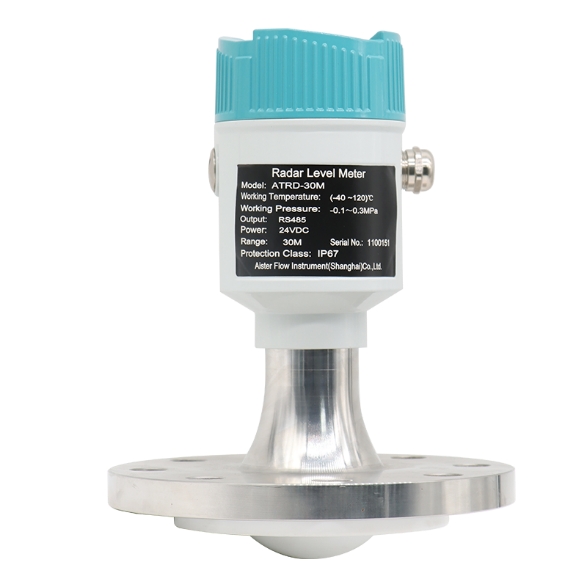What are the influencing factors of radar level gauge blind area
2023-12-26
The 80G radar level gauge is a commonly used instrument in the industrial production process, which is used to measure the liquid level in containers such as storage tanks and tank tanks. By transmitting and receiving microwave signals, it can achieve accurate detection of liquid level. However, in practical application, radar level meter has a problem, that is, blind area. The blind zone refers to the range that the radar level gauge cannot accurately measure, usually appearing in an area at a certain height from the bottom of the sensor. The existence of the blind area may lead to misjudgment or leakage of the level gauge, which brings potential risks and hidden dangers to the production process.

The blind area of 80G radar level gauge is mainly affected by the following factors:
1. Antenna design: the antenna of the level gauge is one of the key factors affecting the blind area. The radiation range and receiving ability of the antenna directly affect the measurement accuracy and sensitivity of the radar level meter. The integrated antenna consists of transmitting and receiving units, which have a relatively small measurement range and are more prone to forming blind spots.
2. Installation position: The installation position of the level meter will also cause the problem of blind area. When the radar level gauge is installed on the top of the storage tank, the energy attenuation of the received signal will be too large due to the long distance between the antenna and the liquid level, thus increasing the size of the blind area. Similarly, the radar level gauge mounted on the bottom can also have a blind spot due to the distance between the sensor and the bottom of the tank.
3. Liquid characteristics: The difference in parameters such as dielectric constant, density and temperature of the liquid will affect the propagation speed of microwave signals in the liquid, thus affecting the measurement accuracy of the liquid level meter. When the dielectric constant of the liquid is large, it is easy to produce interference signals, which may increase the blind area of the radar level meter.
In order to solve the blind area problem of 80G radar level meter, the following measures can be taken:
1. Optimize the antenna design: select the appropriate angular radiation antenna or improve the performance of the integrated antenna to improve the measuring range and sensitivity of the radar level meter and reduce the blind area.
2. Adjust the installation position: Select the appropriate installation height and Angle according to the actual situation to avoid the distance between the antenna and the liquid surface is too large or too small, thereby reducing the blind area.
3. Set parameters according to the characteristics of the liquid: when configuring the radar level meter, consider the dielectric constant, density and temperature of the liquid and adjust the frequency and power of the microwave signal to optimize the measurement results.

The blind area of 80G radar level gauge is mainly affected by the following factors:
1. Antenna design: the antenna of the level gauge is one of the key factors affecting the blind area. The radiation range and receiving ability of the antenna directly affect the measurement accuracy and sensitivity of the radar level meter. The integrated antenna consists of transmitting and receiving units, which have a relatively small measurement range and are more prone to forming blind spots.
2. Installation position: The installation position of the level meter will also cause the problem of blind area. When the radar level gauge is installed on the top of the storage tank, the energy attenuation of the received signal will be too large due to the long distance between the antenna and the liquid level, thus increasing the size of the blind area. Similarly, the radar level gauge mounted on the bottom can also have a blind spot due to the distance between the sensor and the bottom of the tank.
3. Liquid characteristics: The difference in parameters such as dielectric constant, density and temperature of the liquid will affect the propagation speed of microwave signals in the liquid, thus affecting the measurement accuracy of the liquid level meter. When the dielectric constant of the liquid is large, it is easy to produce interference signals, which may increase the blind area of the radar level meter.
In order to solve the blind area problem of 80G radar level meter, the following measures can be taken:
1. Optimize the antenna design: select the appropriate angular radiation antenna or improve the performance of the integrated antenna to improve the measuring range and sensitivity of the radar level meter and reduce the blind area.
2. Adjust the installation position: Select the appropriate installation height and Angle according to the actual situation to avoid the distance between the antenna and the liquid surface is too large or too small, thereby reducing the blind area.
3. Set parameters according to the characteristics of the liquid: when configuring the radar level meter, consider the dielectric constant, density and temperature of the liquid and adjust the frequency and power of the microwave signal to optimize the measurement results.
Share To:
News
- Why is the thermal gas mass flowmeter not affected by pressure strength and temperature?
- What to do when a thermal gas mass flow meter fails?
- How are thermal gas mass flow meters used? What are the applications?
- Under what circumstances is the gas measurement need to be regulated compensated vortex flowmeter
- Why Is The Aister Thermal Gas Mass Flowmeter So Popular ?
- Gas turbine flowmeter manufacturers explain their main advantages in measurement
- Gas turbine flowmeter manufacturer Aister instrument field experience summary
- Aister Instrument Empowerment Conference








